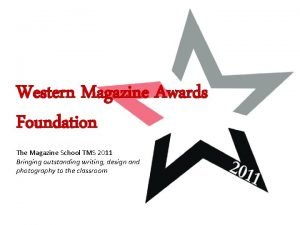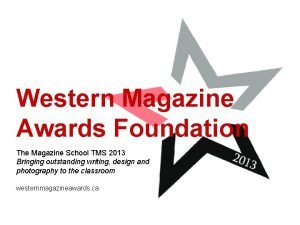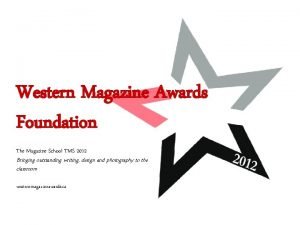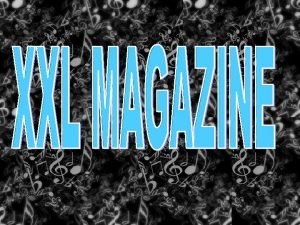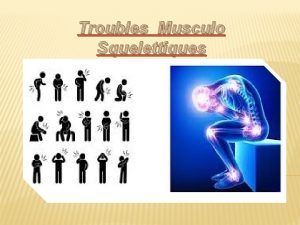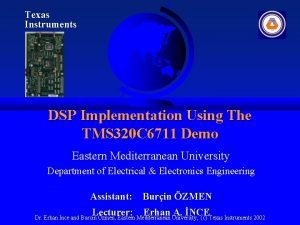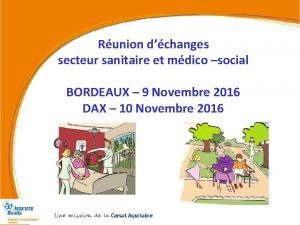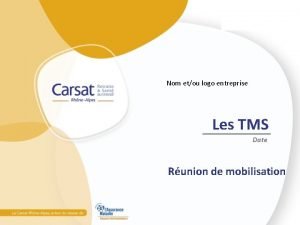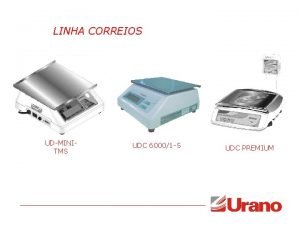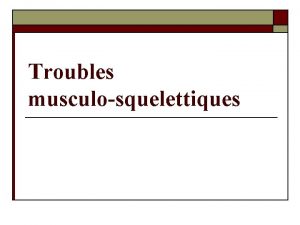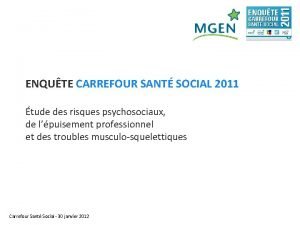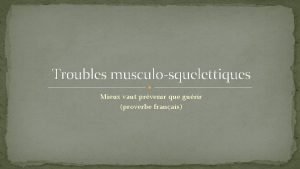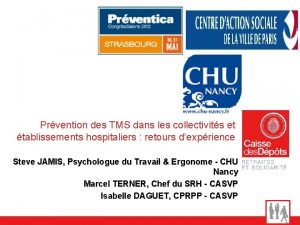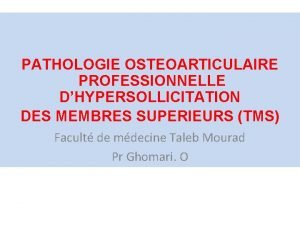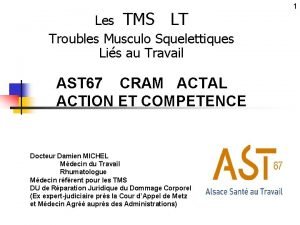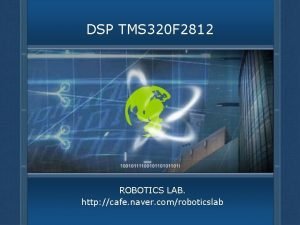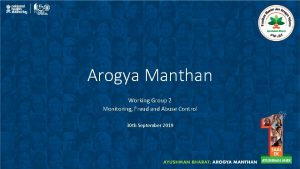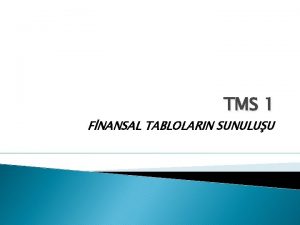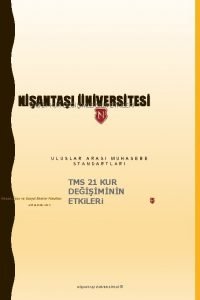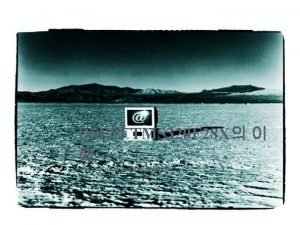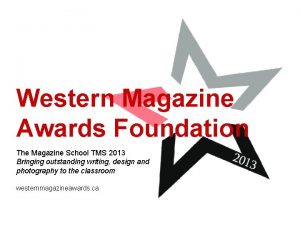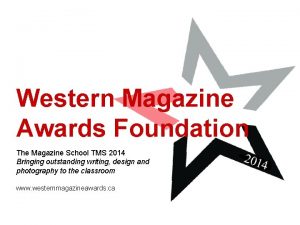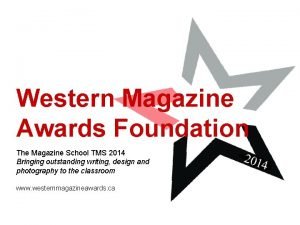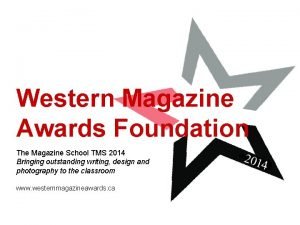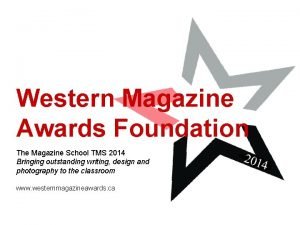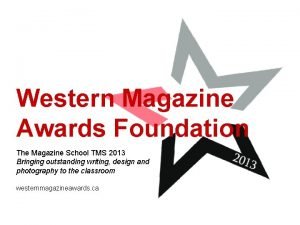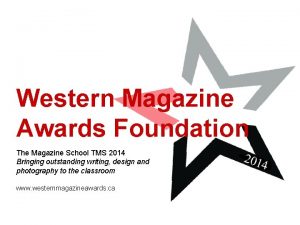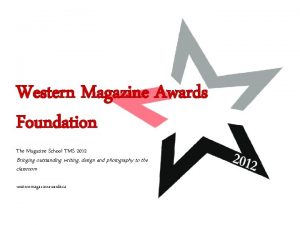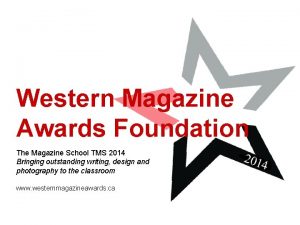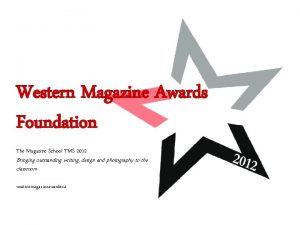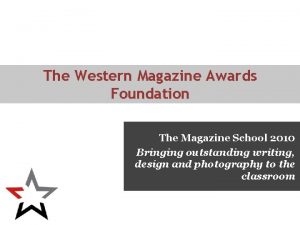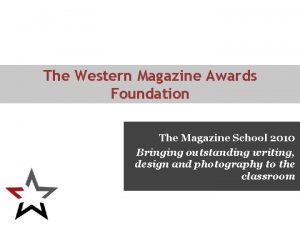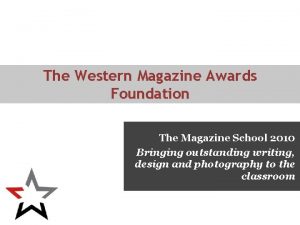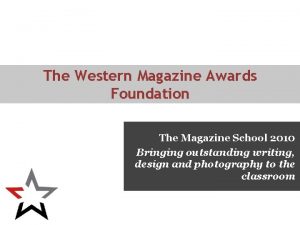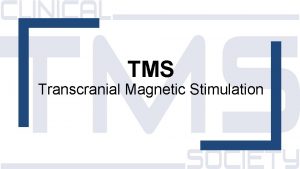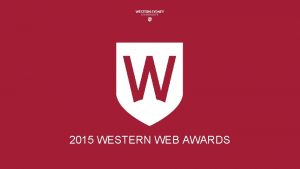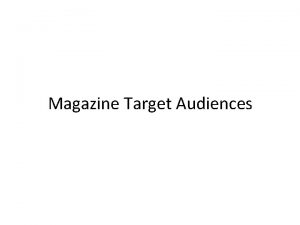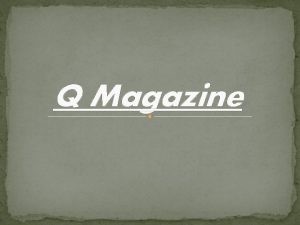Western Magazine Awards Foundation The Magazine School TMS
























![[Headline] Blood Brothers [Deck] In 1984 two soldiers, an Iranian and an Iraqi, meet [Headline] Blood Brothers [Deck] In 1984 two soldiers, an Iranian and an Iraqi, meet](https://slidetodoc.com/presentation_image/817e9189a5bac30a20e886cbd3580ad2/image-25.jpg)















![Numbers to indicate desperation “Pushed [to] the brink, Haftlang jumped ship. He had $200 Numbers to indicate desperation “Pushed [to] the brink, Haftlang jumped ship. He had $200](https://slidetodoc.com/presentation_image/817e9189a5bac30a20e886cbd3580ad2/image-41.jpg)





![Use of dialogue “I held out my Koran to the young man, ” [Aboud] Use of dialogue “I held out my Koran to the young man, ” [Aboud]](https://slidetodoc.com/presentation_image/817e9189a5bac30a20e886cbd3580ad2/image-47.jpg)















- Slides: 62

Western Magazine Awards Foundation The Magazine School TMS 2012 Bringing outstanding writing, design and photography to the classroom westernmagazineawards. ca

Western Magazine Awards Foundation An annual awards program recognizing excellence in Western Canadian editorial work and design. The Magazine School TMS 2012 is a project of the Western Magazine Awards Foundation. It provides classroom material to instructors and professors.

Gold Award Best Article BC/Yukon Finalists: Geist, Stephen Osborne, “Mr. Tube Steak and the Schoolteacher” Up Here, Tristin Hopper, “The Golden Boy and the New Stampede” Vancouver Magazine, Chris Cannon, “The Deserter” Vancouver Magazine, Timothy Taylor, “Blood Brothers” Vancouver Magazine, Tyee Bridge, “Going, Going. . . Gone”

The Winning Entry Is: Vancouver Magazine Timothy Taylor “Blood Brothers”

Accolades for “Blood Brothers”: Western Magazine Award winner – Written Award for Human Experience (sponsored by Canadian Society of Magazine Editors) National Magazine Award nominee – Society

About Vancouver Magazine “Vancouver Magazine informs, guides and entertains people who engage with the city. Mixing quality journalism and service-driven pieces, it chronicles and reflects Vancouver's emergence as a dynamic international city. ” Publisher: Transcontinental Media Published 10 times per year Click here for Vancouver Magazine’s website

Meet the author: Timothy Taylor Award-winning novelist and journalist based in Vancouver Former Big Ideas columnist for the Globe & Mail's Report on Business magazine Winner or finalist of more than 20 Western and National magazine awards Most recent novel: The Blue Light Project Click here for author’s website

Meet the editor: Gary Ross Independent consultant About to launch Modern Farmer, “the economist of food” Former editor-in-chief of Vancouver Magazine and editorial director of Transcontinental Media Author of Stung (1987), a fictional story of a CIBC banker who executed a $10 -million bank fraud; it was developed into the film Owning Mahowny (2003, Philip Seymour Hoffman) Click here for editor's bio on Van. Mag website

Story idea from quiet photo intern Intern Sarah Race sat quietly during an editorial meeting. After, she approached Gary Ross and told him about two men she’d met while volunteering at the Vancouver Association for Survivors of Torture (VAST). "My eyes opened about three inches. ” – Gary Ross Click here for VAST website

The story Iranian soldier Zahed Haftlang stumbles upon injured Iraqi soldier Najah Aboud in May 1982. Instead of executing his enemy, Haftlang saves him. After 20 years, they meet by chance in the waiting room of VAST in Vancouver, B. C.

The reaction "I might just quit my job right now and take that on as a magazine piece, and then as a book project and then as a film. . . In the end, I decided I did not want to stop being the editor of Van. Mag. . . but it was a fantastic story. Who would be a great person to write it? ” – Gary Ross

Writer Timothy Taylor is approached Taylor had won a Western Magazine Award for his food culture series in Vancouver Review.

Research approach “I very much wanted this to be driven by the personal stories of the men involved. My strategy was to sit down and say ‘start at the beginning and tell me what happened. ’ ” – Timothy Taylor

Two primary sources Zahed Haftlang is Iranian Najah Aboud is Iraqi

Interviewing sources Interview with Aboud was shorter. Aboud seemed more interested in moving forward with his new life in Canada. Trust developed between Haftlang and Taylor. Haftlang gave Van. Mag permission to use what they needed, including propaganda image in Persian text of Basij martyrdom.

Researching Iran-Iraq war Taylor read extensively about the history of the Iran-Iraq war to confirm facts and understand both sides involved "outside of the frame of the story. "

Advice from the editor Gary tells Timothy not to worry about word count too much. "Is it unnecessarily detailed? Is there any fat in it? Is there a way of making it sort of tighter? But don't feel constrained by a word count. We went about it that way. ” – Gary Ross


Word count "I wrote it quite long because it was such a magnificent story. . . The story as it was told to me was just so rich and so Biblical in its proportions. ” – Timothy Taylor

Word count Draft article was cut from "very long" to "modestly long. ” Magazine pieces are getting shorter – 5, 000 to 6, 000 words is now unusual. Blood Brothers ended up at 5, 250.

Word count During Ross' six years working at Vancouver Magazine, “only a handful of times” did they run pieces in excess of 5, 000 words.

Assessing truth "How much of this is actually literally true? " "You've got two guys saying this happened and that happened and you have no real way of corroborating the details. . . We decided in the end we just had to let them have their say. ” – Gary Ross

Story Components

Headline and Deck
![Headline Blood Brothers Deck In 1984 two soldiers an Iranian and an Iraqi meet [Headline] Blood Brothers [Deck] In 1984 two soldiers, an Iranian and an Iraqi, meet](https://slidetodoc.com/presentation_image/817e9189a5bac30a20e886cbd3580ad2/image-25.jpg)
[Headline] Blood Brothers [Deck] In 1984 two soldiers, an Iranian and an Iraqi, meet on the battlefield. Amazingly, 20 years later, in Vancouver, they meet again

Headline and deck written by the editor “It just seemed kind of automatic to me. They shared actual kind of blood. . . They shared each other's blood in a literal way and then reconnect so many years later in Vancouver and to have the deep kinship that they share, the title just jumped into my head. ” – Gary Ross

Lead

Lead: First paragraph “East Esplanade in North Vancouver, opposite the industrial waterfront. An unassuming storefront. Powermax Auto Repair reads the sign above the garage door, which is battered from use. Inside, all the typical sights and sounds of an auto mechanic’s shop: the flash and buzz of an arc welder, the radio playing in the background, the big red box of Snap-On Tools, and, of course, the house project car. In this case a 1950 s Pontiac Strato. Chief that sits in a rear corner of the garage, awaiting the attentions of the proprietor as these become available between jobs. ”

Lead: Second paragraph “It’s an ordinary place, in other words. And yet—through the man who founded this shop, Zahed Haftlang, born in Iran in 1968, a survivor of years of war and torture, and a refugee claimant to Canada in 1999—it is extraordinary too for the way it connects Vancouver to a critical place and date in Middle Eastern history. ”

War Background

War background “The date is May 24, 1982. It’s called Day of Martyrs in Iraq and Liberation of Khorramshahr in Iran, both labels referring to what happened that day in one of the bloodiest battles of the Iran/Iraq war: the battle for Khorramshahr. A port city in the oil-rich province of Khuzestan in southwestern Iran, Khorramshahr was an affluent city before the war. But situated on a crucial waterway, it was also a strategic prize. When the Iraqis invaded in September 1980, Khorramshahr was among the first objectives. ”

War background “The fighting was brutal. Tens of thousands of civilians are thought to have died in the assault. And despite committing thousands of troops, a lengthy artillery barrage, and as many as 500 tanks, Iraq faced tenacious opposition. They took two months to secure the area, losing over 6, 000 men in the process. As a result, Khorramshahr became an emblem of resistance to Iranians. In one widely told story, a 13 -year-old Iranian travelled to the city without telling his parents after hearing of the invasion. He fought alongside adult soldiers before being killed disabling an Iraqi tank with a hand grenade. Within months of the boy’s death and the news that Khorramshahr had fallen, thousands of Iranian boys had volunteered. Haftlang was one of them. ”

Bio: Zahed Haftlang “He’d been living east of Khorramshahr in Masjed Soleyman. He was 12 and had nine sisters and five brothers. Home life was difficult, especially with his father. One incident in particular spurred him to action. He was caught stealing money from his father to go to the movies. His father punished him by branding his heel with a skewer heated to red hot in the stove. Haftlang recuperated at a friend’s house, where they concocted a plan to run away to war. ”

Najah Aboud introduced “Najah Aboud didn’t volunteer to fight. He shakes his head remembering, his hands wrapped around a warm cup of coffee in a shop on Commercial Drive. His memories are troubling and his English is patchy. But he agrees to walk me through the painful story. He worked in a Basra restaurant before the war. He was 21, with a girlfriend a son he loved very much. He’d been on a trip to Morocco when Iraqi authorities recalled all eligible men to join the fight. ‘You went, ’ he tells me. ‘If you didn’t, there would be big trouble for your family. ’ ”

Story Tension

Key moral decision “It was a pocket-sized copy of the Koran that did it. As Haftlang stood over the wounded Iraqi, he held out a blood-soaked copy of the holy book. When he took it, Haftlang found among its pages a photograph: a young woman and child, the man’s family. And thinking of these loved ones left behind, the young Haftlang suddenly didn’t know what to do. ”

Descriptive passages “There were many ports still to visit. Time stretched like an ocean around Haftlang, who desperately missed home, missed Maryam and his new daughter. He’d reached the depths of depression by the time his ship steamed down an unfamiliar green arm of water, the Juan de Fuca Strait, through whitecaps into Georgia Strait, then towards the pearly glint of a city nestled on a fold of land at the base of snow-covered mountains at the lip of a cobalt sea. This foreign place was called Vancouver. ”

Use of Numbers

Numbers “Over the next two days, 70, 000 soldiers of the Iranian Revolutionary Army fought their way into the city. The youngest and greenest Basiji were held back to use in a second wave, which was unleashed May 24. ”

Numbers illustrate the scale of war “And despite committing thousands of troops, a lengthy artillery barrage, and as many as 500 tanks, Iraq faced tenacious opposition. They took two months to secure the area, losing over 6, 000 men in the process. ”
![Numbers to indicate desperation Pushed to the brink Haftlang jumped ship He had 200 Numbers to indicate desperation “Pushed [to] the brink, Haftlang jumped ship. He had $200](https://slidetodoc.com/presentation_image/817e9189a5bac30a20e886cbd3580ad2/image-41.jpg)
Numbers to indicate desperation “Pushed [to] the brink, Haftlang jumped ship. He had $200 and the clothes on his back. He ended up sleeping in Stanley Park, shivering and wet, hating the greenery, hating the rain. He missed the comfort of his dry, brown desert home. Two weeks he lasted. Then he stumbled into a corner store to spend his final 50 cents on food and the Iranian owner recognized him as Persian. ”

Use of Scene Re-Creation

Scene re-creation “He fell to the floor of the bunker, literally under the bodies of friends and comrades. He didn’t realize it at the time, but he was himself badly wounded. He’d taken a bullet under his helmet, which had deeply gashed his scalp. He’d also been wounded in the arm. He was losing blood and consciousness. Eventually the firing stopped and the Iranian troops withdrew. Aboud lay in darkness. At some point, his eyes blinked open; above him, through the deathly gloom, he saw a light. ”

Narrative Technique of Anecdote

Anecdote Author recreates the story: “Back in Iran, Haftlang did his debrief interviews with intelligence officials, then tried to settle back into a life he hadn’t known in 10 years. He returned to his hometown where his childhood home was still standing. But when he knocked, a stranger opened the door. She invited him inside, but he ran to the graveyard instead, thinking his parents must be dead. There he found a family tombstone. Only it had his own picture on it. Frightened graveyard workers, seeing the man who was supposed to be in the ground, tried to explain that his family had assumed him dead. Haftlang collapsed to the ground at this news. ”

Dialogue
![Use of dialogue I held out my Koran to the young man Aboud Use of dialogue “I held out my Koran to the young man, ” [Aboud]](https://slidetodoc.com/presentation_image/817e9189a5bac30a20e886cbd3580ad2/image-47.jpg)
Use of dialogue “I held out my Koran to the young man, ” [Aboud] said. “It had a picture of your wife and son!” Haftlang told him. “The boy had a light. ” “My flashlight!” Haftlang said. – The Blood Brothers' chance reunion “When Najah came into that room, ” [Haftlang] tells me, “a new window opened in my life. And my depression disappeared. ”

Author recreates dialogue “How did you get to Canada? ” Najah Aboud thinks and scratches his chin. “It’s a long story, ” he says. “Let’s just say my brother helped me. ” I try again: “How’d you feel when you arrived here? ” “Good. Strong, ” he says, brightening.

Writer’s Presence

Writer stays out of the story "I'm there to show the story begin and then there's just no need for me to be there. I had nothing to say. I had nothing to react to. The story was on the page. ” – Timothy Taylor

Use of Quotes

Quotes “I thought maybe that, like me, life had brought him here. So I decided to help him, contrary to our orders. ” – Zahed Haftlang “There are bad memories. ” – Najah Aboud, recounting memories over coffee

Ending

Ending: First paragraph “We walk out into the garage. I can hear traffic on the Esplanade, airplanes and boats in the harbor beyond. Haftlang has closed his shop for the afternoon to tell me his story, and now he’s going to pull the chain and raise the heavy front door again. And then business and clients and auto repairs will begin again. ”

Ending: Second paragraph “But not before he shows me the Pontiac Strato. Chief. A fine project. He has the engine out and is rebuilding it. When the whole thing is done, it’ll be perfect, you can tell already. Something from history, something destined for the junk pile, brought back to life and entirely restored. Made new. ”

Symbolism of Strato. Chief Pontiac Strato. Chief: A symbol of new beginnings

End with new understanding The art of going full circle. Story begins and ends in Haftlang's garage, with focus on the symbolic Strato. Chief. "There a few tried-and-true structures for magazine pieces and one of them is to get back to the beginning somehow to kind of close off the story by going back where you started but having a whole new understanding or a whole enriched outlook. " – Gary Ross

Visual Components

Visual staff Art director: Randy Watson Portraits: Gregory Crow Calligraphy: Carlos Engel

Calligraphy Design challenge: War is difficult to visualize for the reader Calligraphy for title mimics passages of the Qur’an Aim was to capture feel of events from half a world away

“Blood Brothers” expands 2012 radio documentary, Two Enemies, One Heart on Radio Netherlands Worldwide Zahed Haftlang is working on a memoir Taylor is contracted by Doubleday Canada for a book Gary Ross sees film potential Click here for radio documentary website

Credits The Magazine School is a project of the Western Magazine Awards Foundation, which acknowledges the financial support of the Government of Canada through the Canada Periodical Fund of the Department of Canadian Heritage toward project costs. The Magazine School 2012 content was prepared with the skilful assistance of Janice Paskey and MRU students Shane Flug and Jennifer Friesen with the generous cooperation of the winners of the 2012 Western Magazine Awards. We acknowledge the financial support of the Government of Canada through the Canada Periodical Fund (CPF) of the Department of Canadian Heritage towards our project costs.
 Tms yukon
Tms yukon Tms magazine
Tms magazine Tms magazine
Tms magazine Hiphop magazine
Hiphop magazine Process governance
Process governance Pad foundation
Pad foundation Composition of urine
Composition of urine Tms définition
Tms définition Tms texas instruments
Tms texas instruments Brb tms 50c
Brb tms 50c Brb cm 50
Brb cm 50 Note de cadrage tms pro exemple
Note de cadrage tms pro exemple Contractor onboarding
Contractor onboarding Logo tms pro
Logo tms pro Tms correios
Tms correios Tms définition
Tms définition Tms6000
Tms6000 Tms 320
Tms 320 Tms carrefour
Tms carrefour Tms coude
Tms coude Tms training melbourne
Tms training melbourne Tms fashions ltd
Tms fashions ltd Tms
Tms Tms
Tms Tms
Tms Tms 2014
Tms 2014 Railconnect tms
Railconnect tms Dsp tms
Dsp tms Tms signal
Tms signal Tms.pmjay.gov.in login
Tms.pmjay.gov.in login Tam bir finansal tablo seti
Tam bir finansal tablo seti Tms 21
Tms 21 Tms320dm
Tms320dm Tms in ppc
Tms in ppc 320 fahrenheit to celsius
320 fahrenheit to celsius Tms web core crack
Tms web core crack Case western reserve university case school of engineering
Case western reserve university case school of engineering Language english
Language english Wmu msw application
Wmu msw application Hát kết hợp bộ gõ cơ thể
Hát kết hợp bộ gõ cơ thể Ng-html
Ng-html Bổ thể
Bổ thể Tỉ lệ cơ thể trẻ em
Tỉ lệ cơ thể trẻ em Voi kéo gỗ như thế nào
Voi kéo gỗ như thế nào Tư thế worms-breton
Tư thế worms-breton Chúa sống lại
Chúa sống lại Các môn thể thao bắt đầu bằng tiếng đua
Các môn thể thao bắt đầu bằng tiếng đua Thế nào là hệ số cao nhất
Thế nào là hệ số cao nhất Các châu lục và đại dương trên thế giới
Các châu lục và đại dương trên thế giới Công thức tính độ biến thiên đông lượng
Công thức tính độ biến thiên đông lượng Trời xanh đây là của chúng ta thể thơ
Trời xanh đây là của chúng ta thể thơ Mật thư anh em như thể tay chân
Mật thư anh em như thể tay chân Làm thế nào để 102-1=99
Làm thế nào để 102-1=99 độ dài liên kết
độ dài liên kết Các châu lục và đại dương trên thế giới
Các châu lục và đại dương trên thế giới Thơ thất ngôn tứ tuyệt đường luật
Thơ thất ngôn tứ tuyệt đường luật Quá trình desamine hóa có thể tạo ra
Quá trình desamine hóa có thể tạo ra Một số thể thơ truyền thống
Một số thể thơ truyền thống Cái miệng nó xinh thế chỉ nói điều hay thôi
Cái miệng nó xinh thế chỉ nói điều hay thôi Vẽ hình chiếu vuông góc của vật thể sau
Vẽ hình chiếu vuông góc của vật thể sau Thế nào là sự mỏi cơ
Thế nào là sự mỏi cơ đặc điểm cơ thể của người tối cổ
đặc điểm cơ thể của người tối cổ Thế nào là giọng cùng tên
Thế nào là giọng cùng tên
